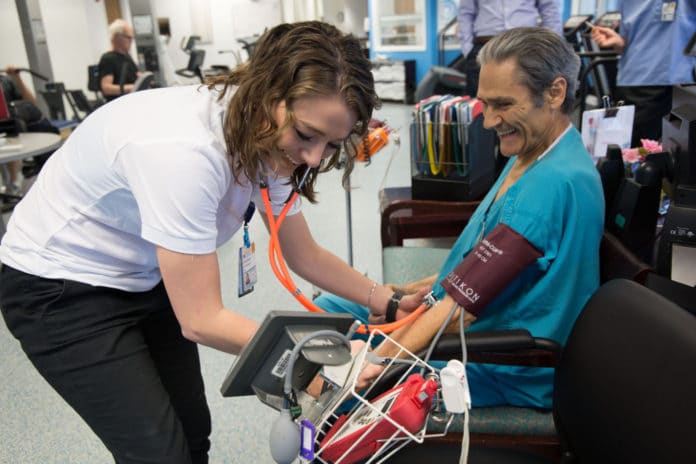Mario Oikonomides credits a massive heart attack when he was 38 with sparking his love of exercise, which he says helped keep him out of the hospital for decades after.
While recovering, he did something that only a small percentage of patients do: He signed up for a medically supervised cardiac rehabilitation program, where he learned about exercise, diet and prescription drugs.
“I had never exercised before,” said Oikonomides, 69, who says he enjoyed it so much he stayed active after finishing the program.
Despite evidence showing that such programs substantially cut the risk of dying from another cardiac problem, improve quality of life and lower costs, fewer than one-third of patients whose conditions qualify them for rehab actually participate. Various studies show that women and minorities, especially African Americans, have the lowest participation rates.
“Frankly, I’m a little discouraged by the lack of attention,” said Brian Contos, who has studied the programs for the Advisory Board, a consulting firm used by hospitals and other medical providers.
Now, though, advocates say cardiac rehab may be gaining traction, partly because the federal health-care law puts hospitals on the financial hook if patients are readmitted after cardiac problems. Studies have shown that patients’ participation in cardiac rehab cut hospital readmissions by nearly a third and saved money.
Oikonomides, who lives in Charlottesville, Va., went for three decades without a second heart attack, but he recently had bypass surgery because of blockages in his heart.
He is again rebuilding his strength at the University of Virginia Health System. “I attribute my 30 good years of life to cardiac rehab,” he said recently while pedaling on a stationary bike in a light-filled gym at an outpatient medical center, a heart monitor strapped to his chest.
But many patients still face hurdles.
Uninsured people simply can’t afford cardiac rehab. And for those with coverage, “the No. 1 barrier is the cost of the co-pay, which is frustrating,” said Ellen Keeley, a cardiologist at U-Va., who strongly encourages her patients to enroll.
Medicare and most private insurers generally cover cardiac rehab for people who have had heart attacks, coronary bypass surgery, heart failure and several other conditions. Most coverage is two or three hour-long visits per week, up to 36 sessions.
Insured patients usually must make a per-visit co-payment. For traditional Medicare members, that runs about $20 a session, although many have supplemental insurance that covers that cost. For patients with job-based insurance – and for enrollees in Medicare Advantage – out-of-pocket costs can range from nothing to more than $60 a pop.
UnitedHealthcare, with nearly 3 million members in Medicare Advantage plans, said patient payments for cardiac rehab vary widely. About 12 percent of members pay nothing, while 23 percent pay $50 a session. Another large insurer, Humana, has a similar range.
Nationally, the weighted average payment for Medicare Advantage members is just a bit more than the $20 that patients in traditional Medicare pay, said Dale Summers, director of the Center for Medicare & Medicaid Services’ division of finance and benefits.
– – –
Another reason so few patients participate is that many are never referred to a program. Some hospitals are addressing this by building automatic referrals into their discharge system.
Patients may be reluctant to attend cardiac rehab, especially if they had not been physically active before their heart problem.
At U-Va., heart attack patients are given an appointment to come back to a special clinic within 10 days of discharge. Over about an hour, patients meet with an exercise physiologist, a cardiologist, a nutritionist and a pharmacist – all in the same exam room. Patients are encouraged to join U-Va.’s cardiac rehab program but are also given information about exercising on their own.
Patients face other barriers to this kind of care, including time constraints and having to travel long distances to the nearest program.
And existing programs aren’t enough to accommodate all patients who are eligible. A recent study that surveyed 812 cardiac rehab programs found that even if they were expanded modestly and operated at capacity, they could serve only 47 percent of qualifying patients.
“We have patients who are an hour away from any cardiac facility, and they can’t afford the gas money or the time,” Keeley said.
Take Kathryn Shiflett of Culpeper, Va. At age 33, the last thing she expected was a heart attack.
But one night in late March, she felt pain in her arm – pain that spread to her jaw – and she felt nauseous. After tests at a local hospital, she was transferred to U-Va., where cardiologists opened a blocked artery in her heart.
Shiflett, a medical worker with two children, returned to U-Va. a week later for her clinic appointment and was encouraged to participate in cardiac rehab there.
Shiflett found the program appealing because she wants to be active and prevent a repeat of her heart attack. But she lives an hour away and isn’t sure she can make the sessions. Cardiac rehab classes are held during working hours, with the latest of them starting at 3 p.m.
“I’m not sure I can get there by then,” Shiflett said.
One alternative might be a home-based program, an approach that is less common but drawing increased interest.
“There are a whole plethora of different ways to provide cardiac rehab outside the traditional center model,” said Mark Vitcenda, senior clinical exercise physiologist at the University of Wisconsin Hospital and Clinics in Madison.
At his program, patients can start in a supervised program at a center for two or three sessions, then continue in a home-based model with occasional visits to the center. About 30 to 40 percent of the Wisconsin program’s patients choose the home-based option, he said, with most being younger, working patients.
“If we can lower the barriers of transportation and cost, patients are able to be more involved,” he said.






